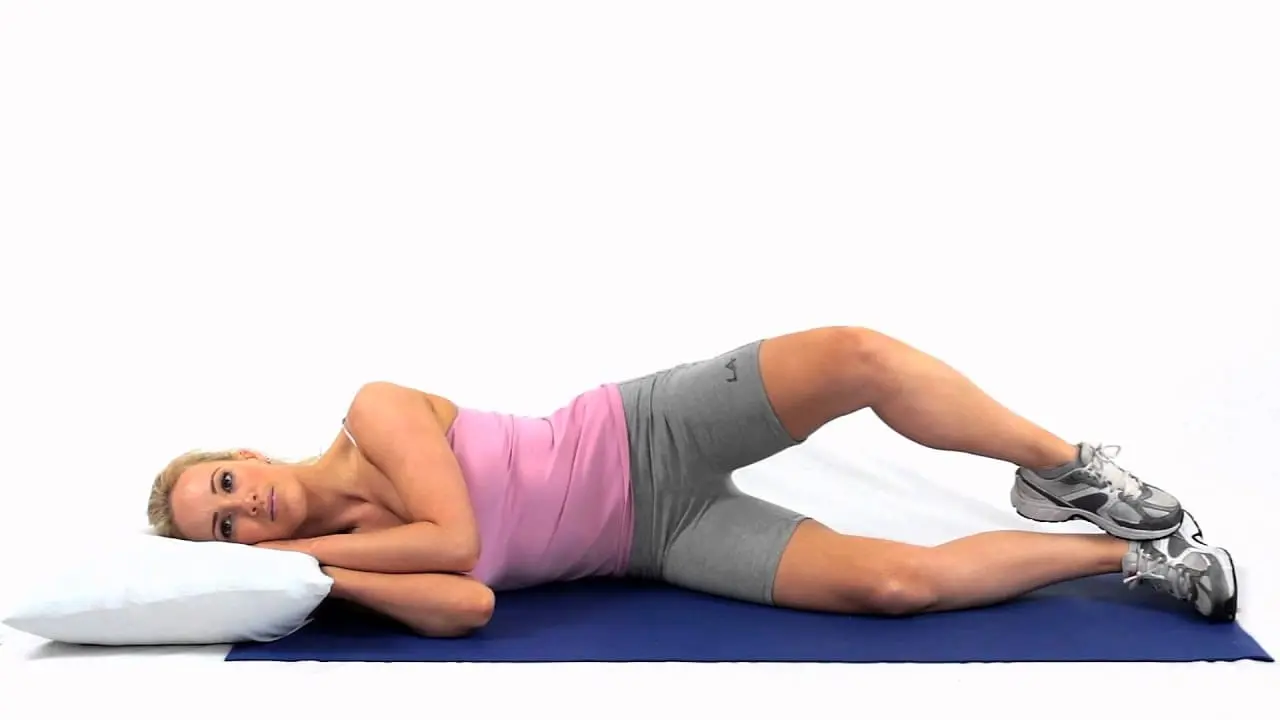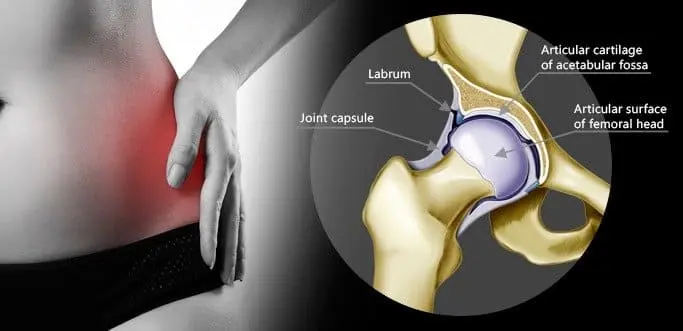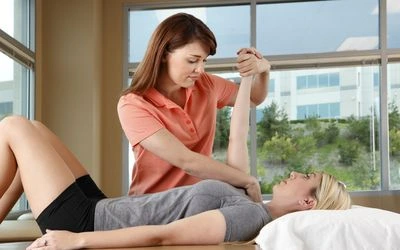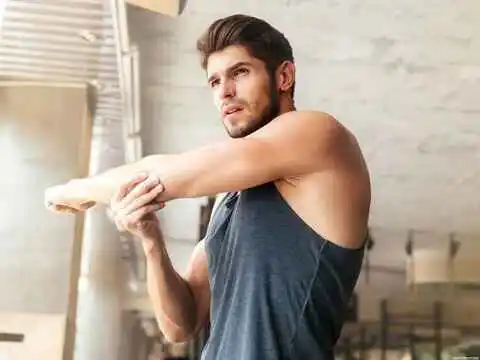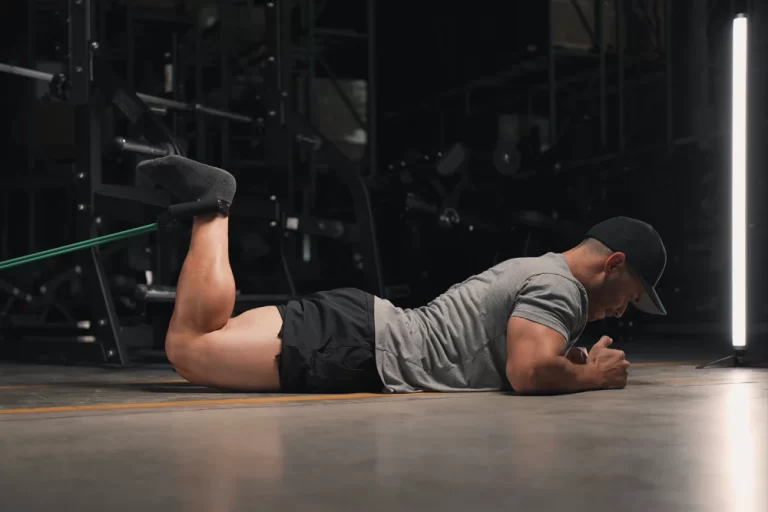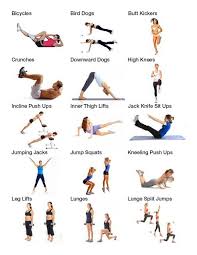15 Best Exercises for Hip Bursitis
What is Hip Bursitis?
Hip bursitis is a very common illness that can arise from inflammation of the fluid-filled sacs that surround your hip joints. Your body naturally reacts this way when you lift more weight, work out more, or engage in other activities that put more strain on your hips.
You can get advice from your physical therapist or doctor regarding the ideal times to start and finish your exercises for hip bursitis. Stretching and exercising should be done two to three times a day if tolerated, and one to two times a day, respectively. A floor mat could be helpful, and a cushion or pillow is needed. Every activity should be started carefully, and if you start to feel pain, stop.
You might benefit from physical therapy if you have hip bursitis. Your therapist is qualified to evaluate your condition and identify the underlying mechanical causes of your issue. You can then put methods into practice to increase your strength and functional mobility.
Exercises for Hip Bursitis:
Exercise can be highly important in the healing process from hip bursitis, even though rest and medication may also be required. The muscles that surround the hip joint can be strengthened, flexibility can be increased, and healing is made easier by suitable physical activity.
Lying lateral leg raises
- Start with a relaxing side-lying position on the ground.
- You can either bend your arm to support your head in your hand or keep it straight on the floor.
- Keeping your leg straight with your toes pointing ahead, carefully raise your upper leg.
- Avoid twisting your hips.
- Hold this position for a few seconds.
- Then return to your neutral position.
- Then relax.
- Repeat this exercise 5 to 10 times.
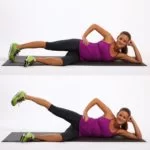
Hip bridges
Glute bridges are a bodyweight exercise that targets your glutes, lower back, and core muscles. Reducing strain at the sides of the hips can be helped by increased strength in these regions.
- Both of your feet should be flat on the ground as you lie on your back with your knees bent.
- Raise your hips without causing your back to arch.
- Squeeze your abdominal muscles.
- Hold this position for a few seconds.
- Then return to your neutral position.
- Then relax.
- Repeat this exercise 5 to 10 times.
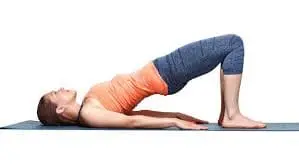
Iliotibial Band Stretch
As a result, your outside hip will be stretched.
- Standing with your back to a wall for support is necessary for this type of exercise.
- It is best to cross the leg nearest to the wall behind the leg on the other side.
- Bend your hip so that it is resting against the wall and feel for a stretch on the outside of it.
- Cross the leg behind the other leg that is the furthest from the wall.
- Hold this position for a few seconds.
- Then return to your neutral position.
- Then relax.
- Repeat this exercise 5 to 10 times.
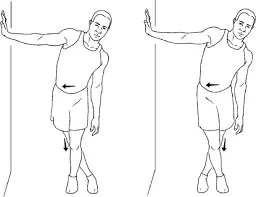
Straight leg Raises
- Begin in a comfortable lying down position on the floor.
- Now slightly bend your one knee.
- Then raise your other leg gradually.
- While the knee on the other side stays straight.
- Next, hold for a few seconds.
- After that, lower your leg.
- Then return to your neutral position.
- Then relax.
- Repeat this exercise 5 to 10 times.
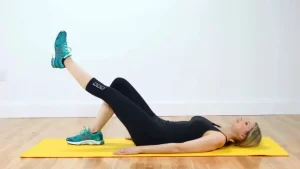
Clamshell
Many glute muscles are used in the clamshell exercise, helping in hip joint stabilization. It could help with lower limb injury treatment or prevention.
- In a side-laying position, bend your knees to a 45-degree position.
- To activate your core, pull your belly button in close to your spine.
- Elevate your upper leg gradually while keeping your feet together.
- Keep your hips from rolling backward.
- After holding for a few seconds at the top, carefully drop your leg to the beginning position.
- Then relax.
- Repeat this exercise 5 to 10 times.
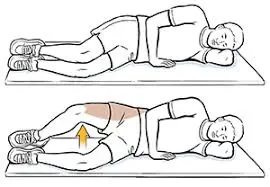
Leg Circles
Exercises like leg circles are also excellent for treating hip bursitis because they help improve hip range of motion, strength, and flexibility.
- You can begin by lying on your back with both legs straight out in front of you on the mat.
- Elevate one leg a few inches off the mat or plinth’s surface, then begin to move it in a circular motion while maintaining its straight posture.
- 3–4 seconds in a single, round motion.
- Then return to your neutral position.
- Then relax.
- Repeat this exercise 5 to 10 times.
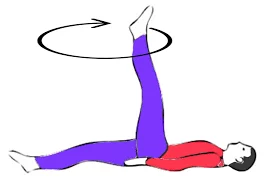
The plank
- Your forearms should be supporting your stomach while you lie down.
- Raise your hips off the floor until they align with your shoulders while extending your legs.
- Use your forearms and toes as support.
- Hold this position for a few seconds.
- Then return to your neutral position.
- Then relax.
- Repeat this exercise 5 to 10 times.
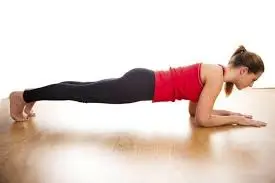
Mountain Climbers
- Placing your hands shoulder-width apart just below your shoulders, begin in the push-up position.
- Pull your right knee as quickly as you can toward your chest, making sure it stays off the ground, and then return it to the beginning position.
- Now repeat the same motion with your left leg.
- Then relax.
- Repeat this exercise 5 to 10 times.
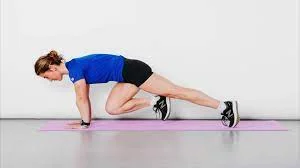
Donkey Kicks
- Start with kneeling position on the ground.
- Place your hands directly below your shoulders and your knees below your hips.
- To maintain a flat back of the neck, slightly droop your chin and turn your head down and outward.
- To engage your glutes, maintain a 90-degree bend in your right leg and extend your right foot.
- Then reach your right leg back behind you toward the ceiling.
- Make sure your body height is just above the point where your hips twist or bend and your lower back arches, which indicates that you may have lifted it too high.
- Keep your hips centered on the floor while maintaining a firm, neutral back.
- Try not to rush your movements to finish the exercise with a full range of motion and proper technique.
- Your right leg should be lowered at first, then raised again.
- Then return to your neutral position.
- Then relax.
- Repeat this exercise 5 to 10 times.
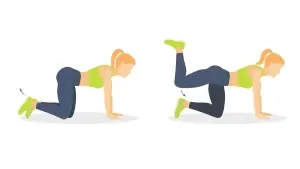
Kneeling hip flexor stretch
- First, bend both knees.
- At this stage, step forward one foot and bend your knee to a 90-degree angle.
- For support, if needed, you might place your hands on the front knee.
- Maintaining the upper body upright.
- After that, bend forward until you feel a stretch.
- Hold this position for a few seconds.
- Then return to your neutral position.
- Then relax.
- Repeat this exercise 5 to 10 times.
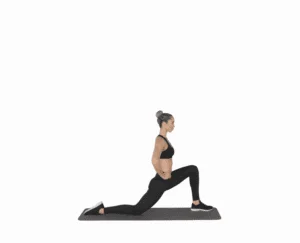
Hamstring Stretch
- Start with a relaxing supine position on the ground surface.
- Lift one leg off the mat with a slightly bent knee.
- Place a resistance band over the sole of the extended leg.
- Bring in the leg as close to your chest as feels comfortable.
- Hold this position for a few seconds.
- After that, go back to your neutral posture.
- Next, relax.
- Repeat this exercise 5 to 10 times.
- Continue with the other leg.
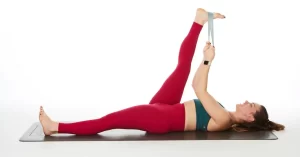
Prone Leg Raise
Strengthening the hip muscles while improving stability are two advantages of the prone leg raise.
- Starting with a comfortable surface (like an exercise mat), lie down on your stomach.
- For support and stability, put your arms by your sides with your palms facing downward.
- Make that your legs are straight and parallel to your body.
- Pull your belly button gently toward your spine to contract your core muscles.
- Start the exercise by carefully raising one leg off the ground.
- Pay attention to engaging your hamstrings and glutes to lift the leg.
- Keep your knee straight while you lift the leg, and try not to arch your lower back too much.
- Raise your leg to a comfortable level while keeping your posture and stability.
- Hold this position for a few seconds.
- Then lower your leg.
- Then relax.
- Repeat this exercise 5 to 10 times.
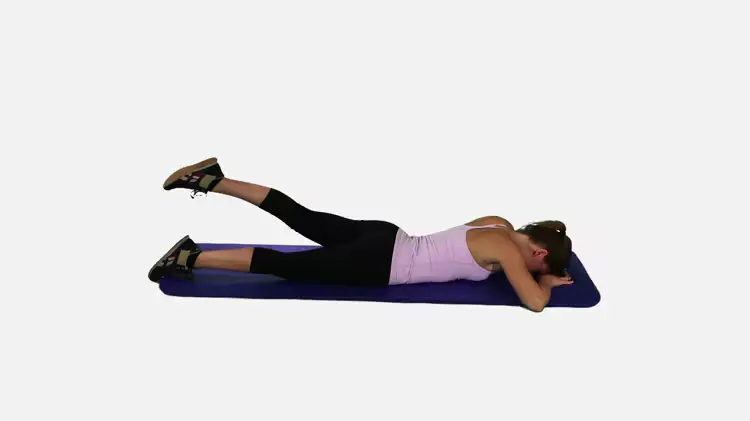
Single Leg Balance
- Place your feet hip-width apart and distribute your weight evenly between your two legs as you stand.
- Your hands ought to be at your sides or on your hips.
- Bend your left leg back at the knee while raising it off the ground.
- You can stand on one leg while holding onto a stable item, like a table or a piece of heavy furniture if you find this too challenging at first.
- Maintain your form correctly and stay in this posture for a little while.
- Then return to your neutral position.
- Then relax.
- Repeat this exercise 5 to 10 times.
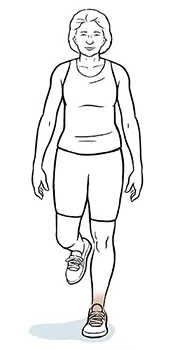
Hip Rotator Stretch
Your deep hip piriformis muscle can be stretched with the hip rotator stretch. By strengthening this muscle, you can increase joint mobility and provide more space for the bursa while avoiding compression.
- One knee should be bent as you lay on your side.
- To extend your hip beyond your bent knee, cross it over and place your ankle slightly over your knee on your thigh.
- With one hand, hold your inner thigh and pass it through the opening created by your crossed legs.
- Your second hand should be able to reach the outside of your leg.
- With your leg bent, extend it across your thigh and knee while maintaining it up.
- A stretch in your hip should be felt.
- Hold this position for a few seconds.
- Then return to your neutral position.
- Then relax.
- Repeat this exercise 5 to 10 times.
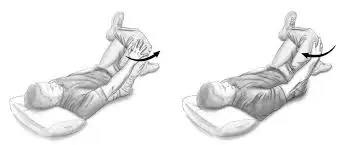
Wall squat with a ball
- Place your head, shoulders, and back against a wall while standing.
- Look directly forward.
- Maintain a relaxed stance with your foot three feet away from the wall and shoulder-width apart.
- A basketball or soccer ball should be placed behind your back.
- With your back to the wall, slowly lower yourself into a 45-degree squat position.
- You will not yet have parallel thighs to the floor.
- Hold this position for a few seconds.
- Then return to your neutral position.
- Then relax.
- Repeat this exercise 5 to 10 times.
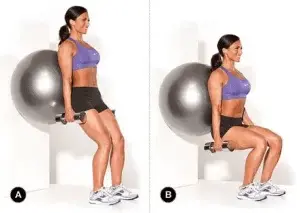
Prevention:
Hip bursitis can be avoided in a variety of ways, such as;
- Stretching often and with the proper grip.
- Three to five times a week, you should engage in hip-strengthening exercises.
- Being physically active and in good shape.
- Maintaining the low back muscles’ strength, range of motion, and strength.
- Your doctor might ask you to change up some of your activities if you start to notice hip pain returning.
- To avoid hip bursitis, all it takes is a few days of rest along with the proper hip muscle stretches and hip joint strengthening exercises.
Exercise Safety Measures:
- Stop exercising immediately if you feel any type of pain.
- During exercise, you should refrain from any jerky or trick hip movements.
- Every exercise should be performed according to protocol, including stretches before each exercise, holds in between exercises, and proper repetitions of each exercise.
- When exercising, it’s best to wear loose or comfortable clothing that allows unrestricted mobility and promotes relaxation. Avoid wearing tight or stylish clothing.
- It may be tough to stretch the tight muscles in your hip joint, but this is normal and even important. It is never okay for stretching or exercise to create stabbing or painful sensations because this is unhealthy and worsens the condition.
- Breathing should never be held during exercise. You should inhale deeply at the beginning of the exercise and release your air slowly through your mouth when finished. Holding your breath can cause muscle tension and elevated blood pressure during physical activity.
When did you discontinue participating in this activity?
- If your doctor advises you to take it easy.
- Just stop exercising if you experience increased pain.
- Don’t continue exercising if you get hip pain.
Exercises to avoid:
- Running
In addition, running is bad for your health because it puts a lot of strain on the hip joint, which is problematic if you already have hip bursitis or an inflamed bursa.
- Bicycling
A bicycle rider’s body is positioned such that the majority of their weight is quickly applied to the hip joint. As a result, during the final phases of the healing process, you should refrain from cycling, and if you must, begin cautiously.
- Any Extended Activity
Activities for treating hip bursitis include sitting, lying down, standing, positioning, and engaging in a variety of healthy exercises, such as swimming, which strengthens your entire body because the water acts as a strong resistance. Greater hip joint pain and disability are present in most people with hip bursitis, and these symptoms might be linked to both total immobility and excessive repetition of motion.
- Cardiovascular Devices
Strong hip muscles are necessary for proper hip flexion when using cardio equipment like ellipticals, treadmills, and stair climbers. Preventive exercises for hip bursitis were supplied with every cardio machine.
- Deep Squats
Exercises involving deep squats also demand an excessive amount of hip muscle strength. There’s no other way to drop as low as possible without severely straining your hip joints.
FAQ:
Is exercising an effective therapy for hip bursitis?
Hip bursitis disorders can benefit from steroid injections and pain and inflammatory medications, but one of the best and most significant forms of treatment is physical therapy or exercise. In addition to helping to prevent and treat the illness, exercise can also lower the risk of developing hip bursitis.
Is bursitis a permanent condition?
Overusing or applying excessive pressure to a bursa surrounding one of your hip joints can result in bursitis, a short-term illness that is typically not chronic. Long-term harm from bursitis is not possible unless you apply persistent pressure to the affected area. so you should try to avoid the condition as much as you can.
For hip bursitis, is walking beneficial?
Patients often benefit from moderate, controlled walking. Stiffness is avoided, hip flexor strength is increased, and joint mobility is preserved during walking all of which can improve joint stability.
Is it possible to remove bursitis forever?
The surgeon may have to cause significant damage to the bursa before removing the inflammatory sac. Stitches keep the wound closed. Bursa excision can permanently lessen redness and pain associated with bursitis without impairing the ability of the muscles or joints to function.
How may hip bursitis be treated alternatively?
Getting regular exercise can help build muscle and relieve pressure on the bursa and other associated joints. Two advantages of yoga include greater mobility and a reduction in tight muscles. While lowering the strain from repeated motions, Pilates and Tai Chi help strengthen muscles and ligaments.
Does hip bursitis get worse at night?
One of the most common symptoms of hip bursitis is hip pain at night, but there are other clear indicators as well, like pain during a long walk or extended duration of sitting. Standing still usually doesn’t cause hip pain.
References:
- NIdhiphysio, Dr. 2022 July 22. Mobile Physiotherapy Clinic: Exercises for Hip Bursitis. Mobile Clinic for Physiotherapy. hip-bursitis exercises are available at https://mobilephysiotherapyclinic.in/
- On May 20, 2024, Pt., B. S. Exercises to Know for Physical Therapy for Hip Bursitis. Very well Medical Center. Hip bursitis physical therapy exercises (page 5199259) | Very Well Health.com
- Prajapati, D. ( May 24, 2023a). Best 8 Hip Bursitis Exercises – Samarpan Physiotherapy. Hip bursitis can be effectively treated with the following 8 exercises listed at Samarpan Physical Therapy Clinic (https://samarpanphysioclinic.com).
- On May 20, 2024, Pt., B. S. Know These Exercises for Physical Therapy for Hip Bursitis. Verywell Medical. Physical therapy exercises for hip bursitis (item number: 5199259)
- February 8, 2023a, Cso. The Top 6 Hip Bursitis Exercises. Center for Orthopedics and Spine. The following are the top six hip bursitis exercises: https://centerforspineandortho.com/news/
- Image 6, Exercises, routines, and workouts on side lying hip circles. (As of now). Side-lying hip circles: https://www.workoutsprograms.com/exercises
- Image 14, M. Gombera (2024, Jan. 19). Four Exercises and Stretches to Reduce Hip Bursitis Pain. Gombera, MD, Mufaddal. This article, “Four Hip Bursitis Stretches and Exercises to Reduce Pain,” was published on Gomperamd.com in the blog section.
- Image 15, Maridav, Dusanpetkovic, Dusanpetkovic, Bulgakov, O., Kristiankettner, Srdjanns, Yoh4nn, Screaghin, A., Hirurg, Baona, Solar, FreshSplash, Ignjatovic, M., Maridav, Source, I., Gremlin, AzmanJaka,… Kristiankettner. (As of now). Squat while pressing your shoulders or throwing a medicine ball overhead. Weighted medicine ball squats are an effective way to train your legs and glutes for a fitness workout. An athlete exercising in the gym. generic image. Wall squats and balls can be found in this image: https://www.istockphoto.com/search/2/image-film

